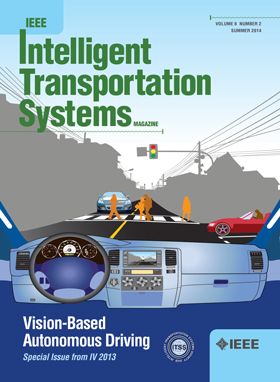A Novel Voronoi-Based Spatio-Temporal Graph Convolutional Network for Traffic Crash Prediction Considering Geographical Spatial Distributions
IF 7.9
1区 工程技术
Q1 ENGINEERING, CIVIL
IEEE Transactions on Intelligent Transportation Systems
Pub Date : 2024-09-10
DOI:10.1109/TITS.2024.3452275
引用次数: 0
Abstract
Accurately predicting the probability of crashes is crucial for preventing traffic crashes and mitigating their impacts. However, the imbalance in crash data, irregular road network structures, and heterogeneity in multi-source data pose significant challenges. To address these issues, this study introduces a spatio-temporal graph convolutional network traffic crash prediction model based on Voronoi diagrams that considers geographical spatial distribution. Initially, this study introduces a spatial partitioning method based on Voronoi diagrams, grounded on the geographic spatial distribution characteristics of traffic crashes. It constructs a novel graph structure with spatial units within Voronoi diagrams as nodes and the shared length of different road types between units as edges. This graph structure integrates the spatial distribution characteristics of crashes with the graph structure, substantially contributing to addressing the zero-inflation problem inherent in spatial units constructed on a grid basis. Subsequently, the study employs a GCN (Graph Convolutional Network) and Transformer encoder to build the VSTGCN (Voronoi-Based Spatio-Temporal Graph Convolutional Network) crash prediction model, evaluating its effectiveness using real data from New York City. Comparisons with eight baseline models demonstrate that VSTGCN outperforms them in all evaluation metrics. Moreover, the paper conducts model ablation studies from different perspectives, such as feature modules and graph structure composition, revealing that the chosen spatial, temporal, and spatio-temporal features significantly influence the model’s predictive performance, with spatial features having the most substantial impact. Finally, the novel graph structure based on Voronoi diagrams proposed in this study shows a clear advantage in model effectiveness compared to traditional graph structures. This research can effectively handle complex crash data structures and accurately predict crash probabilities, providing a reliable basis for developing measures to prevent crashes and alleviate their impacts.基于 Voronoi- 的时空图卷积网络,用于考虑地理空间分布的交通事故预测
准确预测交通事故的概率对于预防交通事故和减轻其影响至关重要。然而,碰撞事故数据的不平衡性、不规则的道路网络结构以及多源数据的异质性带来了巨大挑战。为解决这些问题,本研究引入了一种基于沃罗诺图的时空图卷积网络交通事故预测模型,该模型考虑了地理空间分布。首先,本研究以交通事故的地理空间分布特征为基础,介绍了一种基于 Voronoi 图的空间划分方法。它以 Voronoi 图中的空间单元为节点,以单元间不同道路类型的共享长度为边,构建了一种新颖的图结构。这种图结构将交通事故的空间分布特征与图结构融为一体,大大有助于解决以网格为基础构建的空间单位所固有的零膨胀问题。随后,研究采用图形卷积网络(GCN)和变换器编码器构建了 VSTGCN(基于沃罗诺时空图形卷积网络)碰撞预测模型,并使用纽约市的真实数据对其有效性进行了评估。与八个基准模型的比较表明,VSTGCN 在所有评估指标上都优于它们。此外,论文还从特征模块和图结构组成等不同角度进行了模型消融研究,发现所选的空间、时间和时空特征会显著影响模型的预测性能,其中空间特征的影响最大。最后,与传统图结构相比,本研究提出的基于 Voronoi 图的新型图结构在模型有效性方面具有明显优势。这项研究可以有效处理复杂的碰撞数据结构,准确预测碰撞概率,为制定预防碰撞和减轻碰撞影响的措施提供可靠依据。
本文章由计算机程序翻译,如有差异,请以英文原文为准。
求助全文
约1分钟内获得全文
求助全文
来源期刊

IEEE Transactions on Intelligent Transportation Systems
工程技术-工程:电子与电气
CiteScore
14.80
自引率
12.90%
发文量
1872
审稿时长
7.5 months
期刊介绍:
The theoretical, experimental and operational aspects of electrical and electronics engineering and information technologies as applied to Intelligent Transportation Systems (ITS). Intelligent Transportation Systems are defined as those systems utilizing synergistic technologies and systems engineering concepts to develop and improve transportation systems of all kinds. The scope of this interdisciplinary activity includes the promotion, consolidation and coordination of ITS technical activities among IEEE entities, and providing a focus for cooperative activities, both internally and externally.
 求助内容:
求助内容: 应助结果提醒方式:
应助结果提醒方式:


